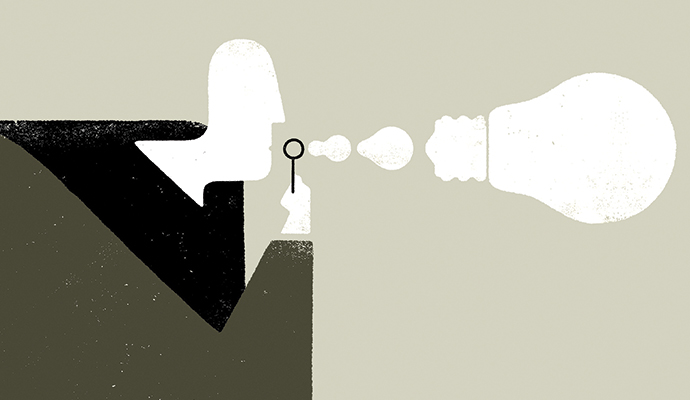A One-Two Punch to Foster Creativity
Both incentives and training are needed to spur innovation.
Title: Facilitating and Rewarding Creativity during New Product Development (Subscription or fee required.)
Authors: James E. Burroughs (University of Virginia), Darren W. Dahl (University of British Columbia), C. Page Moreau (University of Colorado), Amitava Chattopadhyay (INSEAD), and Gerald J. Gorn (University of Hong Kong)
Publisher: Journal of Marketing, vol. 75, no. 4
Date Published: July 2011
Innovation is universally recognized as crucial to a company’s long-term success, but there is little agreement over how to get the most creative contributions from employees. Some companies rely on incentive programs that feature prizes, plaques, or cash. Others offer creativity training programs of one kind or another. And some use both. The combined approach pays off the most, this paper finds, which suggests that firms need to be more creative in their pursuit of creativity.
Many organizations eschew training because creativity is too often viewed as “something mystical or divinely imparted rather than a normal cognitive process that can be enhanced,” write the authors. But in relying on incentives alone to somehow get the juices flowing, companies are ignoring widespread research suggesting that monetary and other rewards can be a drag on creativity because employees tend to view such extrinsic bonuses as an enticement unrelated to the job itself. As a result, their intrinsic motivation — the pursuit of idea generation for its own sake — is diluted.
After surveying firms and conducting several experiments, the authors of this paper concluded that companies should consider a two-pronged approach and offer both training and incentives. This approach benefits employees in two ways, the authors argue: It enhances their capabilities and shifts their interpretation of the bonus from a type of enticement to an affirmation of their valued contribution.
The researchers first established which strategies managers used to stimulate and reward creative thinking among their employees. The researchers conducted in-depth interviews with marketing managers, research directors, and other top executives at 20 firms with annual revenues ranging from US$25 million to $79 billion in North America, Europe, and Asia. Their industries included retail apparel, food processing and distribution, consumer electronics, and medical devices.
Although creativity was found to be crucial — 17 of the 20 respondents said it was most valuable in product innovation and new product development — there were stark differences in how the companies elicited imaginative or inspirational insights.
Strikingly, seven of the larger firms said that they outsourced most of their creative jobs and turned to consultants for help. Of the rest of the 20 firms, only two had formal internal training programs (both of which also offered rewards), five used ad hoc brainstorming sessions, and six did nothing at all to teach creativity.
The researchers also noted variations in how companies rewarded new thinking. Five firms offered no rewards — as one of their executives explained, “Creativity is in the culture and it’s just expected.” At the other 15, rewards included plaques presented at an annual banquet, gift cards, merit raises, and bonuses. In one case, almost $10,000 was awarded for securing a patent.
Overall, the results showed “surprisingly little consistency” in extracting and rewarding creative insights, the researchers write, and the findings reveal “extreme perspectives” on whether firms believe creativity can be taught.
But previous research has shown that even a single training session can enhance creative abilities. People may work smarter because they acquire better skills, and they may work harder, which is often required in creative tasks, because they are more naturally motivated to do something they are good at. But in reality, people who work in creative fields tend to be highly motivated already and expect to be well compensated, meaning that managers who understand how to combine training and rewards could maximize their employees’ performance, the authors reasoned.
To test this theory, the researchers conducted several experiments. In the first, 122 engineering students in the U.S. were asked to design a car jack for use by older adults. Participants were randomly assigned — some received no training or rewards, others got training or were eligible for rewards, and some were offered both. Those who received training were taught how to visualize, in detail, how a potential customer would use a product — a visualization method that has been shown to help engineers produce innovative and effective designs. The top monetary prize was $250, and two judges — drivers older than 60 — evaluated each of the 122 designs on a six-item scale for novelty and usefulness.
The second experiment repeated most of those conditions with different judges and a different group of students. As with the previous experiment, some participants received no training or rewards, some got training or were eligible for rewards, and some were offered both. This time, however, the 110 engineering students received a more general kind of creative training involving visualization, in which they were asked to write a short story about an object coming to life.
The results demonstrated that by combining training with the monetary reward, the creativity effort was greatly enhanced, with those receiving a combination of training and rewards in the first experiment performing a bit better than their counterparts in the second experiment, where the training wasn’t as intense. (Neither the monetary award nor the training influenced the amount of time people spent on the task, meaning that the better performance wasn’t just a result of perseverance.)
Overall, the authors conclude that firms should do more to provide creativity training. The strategy of firms that don’t offer training boils down to “hiring the right people and simply expecting that they will be creative,” the authors write. At the same time, managers shouldn’t turn their backs on offering rewards, despite mounting evidence that they can backfire when used on their own.
It is the combination of training and rewards that produces a result bigger than what either accomplishes on its own, the authors say; companies can thus boast employees who possess both enhanced capabilities and increased motivation.
Bottom Line:
Many firms use bonuses to encourage innovative work from their employees despite widespread findings that this approach can be counterproductive. But monetary rewards can be valuable when paired with formal training on creative thinking, a strategy not widely adopted. In tandem, rewards and training can enhance, rather than diminish, employees’ intrinsic motivation, which in turn helps them produce more creative ideas.



